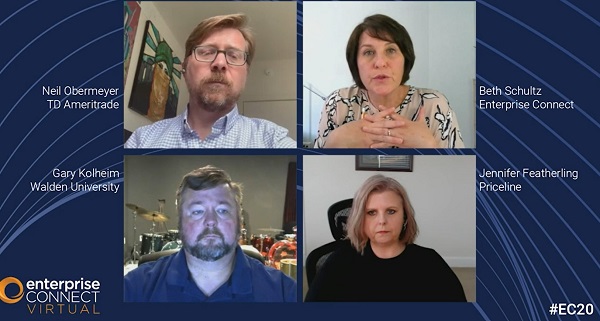It seems to be with that sort of aplomb that the enterprise IT executives who participated in this session, as well as panelists in the
Women in Communications roundtable, have dealt with the COVID-19 crisis. During the Enterprise Summit, we heard from Jennifer Featherling, director of global contact center technology, Priceline; Neal Obermeyer, senior manager of channel effectiveness, TD Ameritrade; and Gary Kohlheim, director of services management at Walden University (Laureate Education) about the communications and collaboration foundations that enabled their companies to move forward during the pandemic with minimal disruption. And, in a further show of resilience, these leaders also gave us a glimpse into their strategies for the future.
Priceline: “In a Great Place”
At Priceline, Featherling has responsibility for all contact center technology in use by around 1,600 agents at various business process outsourcers (BPOs). With the exception of a backend system for customer account information, the company relies entirely on cloud services: Amazon Connect for its contact center platform, LivePerson for messaging, and Verint for workforce management, for example. For business users, Priceline adopted Slack for team collaboration, and BPOs can leverage that too within their contact centers, if they wish to do so, she said.
The pandemic hit Priceline on March 12, with shutdown announcements from Disney and the NBA, Featherling recalled. “We saw massive, immediate call volume coming in” — a 60% increase over the month prior, at a typically slow time of year, she said. By the end of that week, Priceline had decided to start everybody working from home. “We had to go, and we had to go fast, while we were handling all this volume.” As luck would have it, Priceline was “in a great place to be able to do this as quickly,” because it had previously transitioned to Amazon Connect, Featherling said.
Once Priceline got all the agents and their desktops home, Featherling said she then needed to provide special modems or hotspots for some agents, as well as pivot to training agents how to log into and use some apps remotely. Additionally, she addressed some security issues, which had already been on her Q1 roadmap, she said.
“Having made that shift to Amazon Connect was a game-changer for us,” added Featherling, noting that Priceline previously had five disparate contact center platforms. “You know, we wouldn’t have survived, absolutely … if we had not made that shift from a contact center standpoint. I never once worried about trunking. I never worried about the underlying tech supporting it. It was just let the people keep calling … whatever they’re going to do, let it happen,” she said.
Not having to worry about the contact center platform, Priceline has been able to accelerate deployment of a lot of self-service capabilities as well as its ability to offer customers to reach out via the channel of their choice, Featherling said. “We have some more work to do, but we opened up several channels that we were kind of playing with before so they’re fully out there and available for everyone to use.”
Looking ahead to 2021 and beyond, Priceline will continue to improve upon and expand the channels it has in place, Featherling said. “It’s going to be about using our AI and some machine learning to really connect that full trip for the customer and their experience as they go through [their journey].”
TD Ameritrade: “Normalized the Idea of Working Differently”
At TD Ameritrade, Obermeyer sits in communications but as part of a digital workplace partner with technology, with the aim being to gain an understanding of employees, their communications and collaboration needs and, especially, their impediments, he said. TD Ameritrade has just over 10,000 employees, more than half of whom are in direct contact with clients while the others are associates in branches or in the corporate offices. Everyone uses a mix of on-prem and cloud applications, he said.
For example, employees use Slack for team collaboration, Microsoft Office 365 for productivity tools, and a Cisco Webex deployment for cloud videoconferencing, along with several role-specific applications that are either on-prem or in the cloud, he added. In the contact center, agents have access to an on-prem installation of Microsoft SharePoint 2016, for the company intranet and knowledge management system. Supporting contact center workers at home meant giving them softphones — Cisco Jabber — to replace the desk phones they were using in the office.
When the pandemic hit, TD Ameritrade found itself “incredibly well-positioned to transition to working from home based on a number of decisions that had been made years ago,” Obermeyer said. Among those decisions was to move the entire company to virtual desktops, allowing employees to log into their desktops remotely.
While TD Ameritrade couldn’t have foreseen a situation like COVID-19, it did put this foundation in place as a preparedness measure, he said. With virtual desktops, employees were able to keep on doing what they’d always done, just from their homes. Prior to the pandemic, approximately 15% of the workforce worked from home on any given day, compared to nearly 100% within one week of the company issuing its work-from-home (WFH) decision, he added. This includes all call center and retail branch employees, in addition to corporate office workers.
While virtual desktop isn’t in Obermeyer’s purview, communications and collaboration are, and that’s where Slack fits in. Through the digital workplace initiative, TD Ameritrade selected Slack “as the best platform to help us reach our goals for communications and information flow,” and since its implementation, it’s “sitting at a 95% activity rate in Slack,” Obermeyer said. So, well before the pandemic hit, TD Ameritrade had “basically already normalized the idea of working differently and accessing information differently — shrinking that space between people, and what they need,” he added.
But in the early days of WFH, TD Ameritrade did see a surge in video meetings, conducted via Webex, “as everybody wanted to have their cameras on,” Obermeyer said. The team needed to make some bandwidth adjustments, “so we did have a period where we went dark in terms of allowing video,” he said. That said, since April, video meetings have been in full swing, no limitations, he added.
With the COVID-19 experience validating the digital workplace partnership’s decisions on communications and collaboration, the mandate on “understanding the employee experience and understanding the goals and then designing solutions to shrink the space between people and what they need” remains the focus going forward, Obermeyer said. The opportunity for the team is to fast-forward on change management and bring about the mind shift around digital transformation more quickly than possible prior to the pandemic, he added. “We’ll make sure we can continue to focus on that strategy and see where we are able to adjust it in a positive way — that’s going to be the biggest thing for us in the coming months and years.”
Walden University: “Leveraging the Platform”
At Walden, an online university, Kohlheim heads IT operations, including for the communications platform and contact center technologies. In many ways, Walden’s story is similar to Pricelines’ story. Walden is 100% in the cloud, with 4,000 UCaaS/voice users and about 1,200 contact center agents on the 8x8 platform, Kohlheim said. On the contact center side, that includes inbound IVR, chat channels, reporting, analytics, workforce management, and so on, he added.
Because it’s a couple of years into its cloud-first strategy, Walden was able to move staff from office to home in a fairly seamless way, Kohlheim said. Helpful, too, is that everybody worked from a laptop, so his team didn’t need to worry about sending desktops home, he added. That said, some workers have encountered bandwidth and equipment issues, and his team is still sorting some of that out. But overall, between 8x8 and the use of Microsoft Office 365, the cloud “put us in a really good position to be ready for an event like this,” he said.
As part of Office 365, Walden uses Teams, and team collaboration has been especially important for Walden during this crisis, too, especially in development areas, Kohlheim said. Being an Agile organization, a couple of hundred team members would typically come together onsite for planning around the next development cycle. They’ve had to switch to virtual meetings, via Teams, and “that’s really changed the dynamic,” he said. In some areas, he added, the virtual meetings have been quite beneficial, he said. “We were able to do breakout rooms, and collaborate, and we had video, and we even had vendors come in to join us. So, the collaboration piece has been critical for us.”
Despite the changes wrought by the pandemic, Walden really hasn’t had to miss a beat on its strategic IT plans, Kohlheim said. “We were positioned really well to be able to work regardless of where people are located,” he said.
Going forward, he is expanding contact center services into different channels, further developing his AI strategy, and moving more into self-service, Kohlheim said. The focus is on the students, he added, “getting them the information as quick as possible and being consistent across channels, whether it’s a phone call or chat. Providing that same level of service [across channels] is pretty exciting, and we’re fortunate that we’ve been able to stay on that path.”
With the platform well-established, Kohlheim said, “the next year or two is really about leveraging it for more services and features and building integrations.”
Registered attendees can view this session on demand; if you'd like to view the session and haven't registered, there's still time. Register now!











